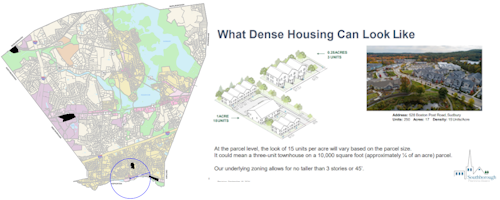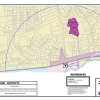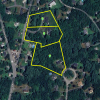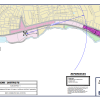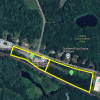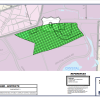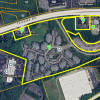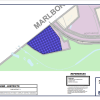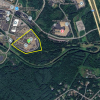Above: The Town will ask voters to approve denser housing by-right in a few overlay districts. (images from the Planning Board’s map and presentation)
On Monday, September 30th, voters will decide at a Special Town Meeting whether to support the Planning Board’s proposal for complying with the state’s MBTA Communities zoning laws.
Passing Article 8 would allow multi-family housing projects would be allowed by right (rather than special permit) in four new “overlay” zoning districts.
Unlike most zoning laws, this one requires only a simple majority to pass.
The Bylaw
The Article adds to the Town code details on what is and isn’t allowed by-right in the zoning districts if the bylaw is passed. Although multi-family units would be allowed, up to 15 units per acre, they still need to comply with underlying zoning laws. That includes the setbacks for each zone and heights. In the residential area near the train station (District 1A & 1B), the maximum by-right height is 2.5 stories or 35 feet. In the commercial zones, it is 3 stories or 45 feet.
And the elimination of Special Permits doesn’t mean there is no Planning Board oversight. In a September 9th presentation, Member Marnie Hoolahan reiterated that the board still has discretion on development projects through their Site Plan Review. Under Site Plan Approval, it is presumed that the board would approve some version of the project, but they can impose reasonable conditions.*
 In a presentation posted to the Town website, the Planning Board provided a visual aid (image right) for the type of denser housing project that might be approved.
In a presentation posted to the Town website, the Planning Board provided a visual aid (image right) for the type of denser housing project that might be approved.
It also pitches benefits to Southborough:
- A modest step to provide zoning to build more diverse housing
- Included as a goal in our 2021 Master Plan to provide more diverse housing
- #1 priority in our housing production plan
- 90% of our housing inventory is single-family homes
- Potential to provide housing opportunities for younger and older generations seeking to enter or stay in Southborough
- Provides for 10% of potential developed units to contribute to our
- Southborough Affordable Housing Inventory
- Districts proposed ensure a gradual impact over time
- Contributes to our community responsibility towards easing the housing crisis
The board also warns of the consequences if the Town doesn’t pass a bylaw by the end of this calendar year. The Town would be ineligible for some state grants and have “reduced consideration” for many others. The presentation notes that grants help the Town reduce costs for taxpayers. Ones they hope to get in the near future include a One Stop Grant for a Route 9 study and sewer evaluation and MassWorks grant to support Route 9 Sewer overhaul.
Plus, the Attorney General Andrea Campbell has pledged that her office will pursue “civil enforcement actions” against Towns that fail to comply with the law. (Scroll down for more on that.)
Many people have referred to the zoning as an affordable housing measure. It isn’t. The board was able to include a requirement for at least 10% affordable but only for incomes at 80% of median wages for our area. But the state argues that increasing available housing across the state will make a difference.
For the full proposed bylaw, click here.
Planning Board Member Marnie Hoolahan will be creating a video of her presentation to share with voters via Southborough Access Media leading up to the meeting. You can look for that to be made available here.
Overlay District Maps
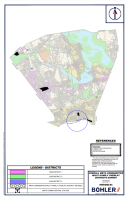 The board scored and ranked possible parcels to use. The scores were based on a combination of input from mapping sessions and other rubrics. Metrics included weighing the impacts for traffic and neighborhood disruptions and eliminating properties with historical buildings or identified as open space priorities.
The board scored and ranked possible parcels to use. The scores were based on a combination of input from mapping sessions and other rubrics. Metrics included weighing the impacts for traffic and neighborhood disruptions and eliminating properties with historical buildings or identified as open space priorities.
Below are the districts they came up with.
Districts 1A and 1B were selected to meet the state’s requirements for at least 10 acres within a ½ mile of the MBTA Commuter Rail station. Multiple districts were allowed, but each had to be comprised of at least 5 acres of contiguous land.
District 1A is in a neighborhood area between Woodland Road and Blendon Woods Drive (190 and 194 Woodland and 10 Blendon Woods).
District 1B is along Southville Road, east of the station (30 Southville and the adjacent parcel to the east). The easternmost parcel is technically just beyond a ½ mile of the station. The board said they are allowed to include it, since the abutting properties have the same owner.
Districts 2 & 3 are on commercially zoned land, one of which is the site of a current 40B development.
District 2 is on Route 9 East. It is comprised of Madison Place and abutting properties, including the gas station and the commercial parcels between the 40B development and Crystal Pond Road. (1200 Madison Place, and 300, 302, 304 & 334 Turnpike Rd)
District 3 (34 St. Martin Street) is a commercial property off Marlborough’s D’Angelo Street on our northwest border.
Public Debate on the Pros and Cons
At the September 9th meeting, several members of boards/committees commented for or against the Article. Most noted that they were speaking as residents. (Consider this a preview of arguments that are likely to be made at the Town Meeting.)
Al Hamilton opined that the Planning Board did a reasonably good job on a thankless task. He advocated for the Article as an important step for increasing diversity of housing options for seniors who want to downsize.
Hamilton explained that property taxes as the biggest cost for most seniors in town. He said many worry about “being essentially taxed out of the home that they’ve made for many many years”.
Ellen Marya pointed out that while the senior population has grown over time, the population of 20-39 yr olds dropped from 31% to 18%:
Those are kids of older adults who grew up in Southboro are nearby and want to move back to raise their own kids here and they can find a place to live to do so. And so I think it’s important that we honor what’s in our housing production plan and do this.
Doug Manz highlighted the loss of starter homes in town. He said the ones that are left are getting torn down quickly and replaced with McMansions. He worried that in the future, his kids won’t be able to live in town. If he and his wife sells the home to their kids in the future, they won’t have options to stay in town themselves. So he appreciates the effort to diversify options.
There are people who have publicly (or privately to me) argued that Southborough should join a “fight” against the state mandate or at least wait to hear what the courts say.
Fighting the law is a position that Howard Rose argued at the September 9th hearing. And Freddie Gillespie argued for waiting until after the Mass Supreme Judicial Court rules on the lawsuit filed by the Attorney General (AG) against the Town of Milton.
The SJC case will hear the case on October 6th, less than a week after the upcoming Town Meeting. Milton’s situation is quite different than ours, in that they claim to have been misclassified as a Rapid Transit Community.
(There have been complaints about Southborough’s Commuter Rail Community status, given that our station is on the Hopkinton border. But after the Town complained about being forced to fit zoning in a ½ mile semicircle (along with other challenges in that section of town), the state revised requirements to allow most of the zoning to be placed outside of the ½ mile circle.)
Gillespie expressed upset about the inclusion of District 1B on Southville Road near her home. She argued that it will be quickly developed with 90 units. She also argued that the underlying height and setback restrictions could be waived if the developer seeks and gets approval from the Zoning Board of Appeals.
She followed that if the Town later learns through SJC’s decision that it could do some things differently, the development would already be grandfathered in by then under the bylaw passed on September 30th.
Earlier in the meeting, Rose asked the board why it hadn’t addressed what the impact would be to the town, including on traffic, schools, and additional police. He questioned why the Town wasn’t joining “16 other towns have already said no and rejected” the state mandate, “saying this is a disaster for our town”.
Vice Chair Jesse Stein told Rose that Planning had many discussions on the concerns he raised, and also the town’s lack of sewer. He followed that the reason he supports the Article is:
it’s a state law and if we don’t do what we can control in terms of mitigation we will possibly end up with a far worse scenario in the future.
Rose argued that the AG’s office is using scare tactics and that the law only actually includes the loss of three grants as a penalty.
Chair Meme Luttrell countered that the AG’s filing in the Milton case asks for relief that would leave the town vulnerable. It is worth noting that the complaint actually requests a multi-stage injunction that would begin with giving Milton 3 months to create a compliant zoning district. Other penalties would only kick in if they failed to do that.
Lutrell also argued that studies have found that adding multi-family homes has “minimus” effect on the schools. She referred to a recent MAPC study. (I found a 2017 study here and a more recent “mythbusting” fact sheet related to the MBTA Communities law here.)
Rose argued that they were adding 900 units to the town. Luttrell rebutted that they are only adding zoning “and we were careful that it takes place over time”. She followed that there is a housing crisis and diversification of Southborough’s housing was one of the major goals in the Town’s Master Plan
It seems that the single family zoning has contributed to the expense of housing in the Commonwealth and across the country and having a diversity of housing stock could help.
Select Board Chair Kathy Cook highlighted that Planning worked hard to designate areas that wouldn’t cause “overnight” development. She pointed out their choice not to include the EMC property for that reason. She also stressed that Town officials had complied in bringing Articles to Town Meetings. It was voters who rejected them.
And Marya clarified that while Articles had failed at Town Meeting for 14 towns, seven of those were already working to bring back Articles to another Town Meeting this fall/winter.
In opposition to Rose’s and Gillespie’s concerns, developer John Bartolini argued against the inclusion of districts that won’t encourage rapid development. (He did agree with Gillespie that District 1B will invite development.)
Looking at Districts 2 and 3 especially, he was dismayed that the board selected parcels that would require tearing down commercial properties to build housing, rather than vacant lots that he owns. He argued that the parcels they chose won’t created the diverse housing options they claim to be in favor of.
Luttrell rebutted “we didn’t choose anything”, defending districts were based on the residents’ selections in mapping sessions and public feedback on important considerations for their rubrics.
Bartolini also noted that many Towns that passed the zoning simply took zoning laws that allowed multi-family by special permit and made it by right.
There may be amendments on Town Meeting floor
The board has held public hearings, incorporated bylaw edits from the Attorney General’s office’s comments, and posted final versions Members don’t expect to make any significant changes to the Article. But they may need to request some adjustments on Town Meeting floor if advised/directed to by the EOHLC (Massachusetts Executive Office of Housing and Livable Communities).
Towns are encouraged to submit their maps well in advance of a Town vote to pre-clear that they fully comply with the state law and regulations. Normally, the board would hear back in a letter from EOHLC. But since the Town complained that the process delays weren’t their fault, and time is tight, the agency agreed to hold a call next week to go over the proposal.
[Note: That won’t be a public meeting since it won’t include a quorum of Planning Board members.]
As is the board’s tradition, they won’t close the public hearing until a meeting right before Town Meeting opens. That will give them a final chance to vote on any potential amendments. It also gives the public one last chance to make a case for the board to make changes.
It is also possible that individual voters will propose amendments of their own at Town Meeting. That is something that frequently happens with zoning and other controversial Articles.
The Select Board has voted to support the Article as written. The Advisory Committee opted to wait until Town Meeting to vote on/share a position.
*If an applicant is in violation of the Town’s bylaws, and conditions aren’t enough to bring it into compliance, then the board could reject it. And, of course, an applicant could choose to sue if they deem conditions to be unreasonable.
**Milton’s Rapid Transit Community classification comes with a higher level of required multi-family zoning to be added than our Commuter Rail Community standing. It is written as applying to communities with subways or the silver bus line. In Milton’s case, the state pointed to their Mattapan Trolley, which residents say is too slow and antiquated to qualify as rapid transit.
Updated (9/21/24 10:55 am): Yesterday, an “Opposition Presentation” was posted under the handouts on the Town Meeting page. It argues against the inclusion of District 1B as “inappropriate” and “bad for all Southborough residents”. It proposes:
- Have the Select Board and Planning Board reach out to all the other towns that haven’t passed the bylaw and go to the state and argue that this One Size Doesn’t Fit All.
- Wait until the Milton Case is decided to see what the consequences really are.
- Planning Board work to remap the lots to make the site locations work for not only the current residents but the future residents with children
You can read a pdf version here.
Last night, Southborough Access Media posted Marnie Hoolahan’s video presenting Article 8 on behalf of the Planning Board. You can view that below or here.
Updated (10/23/24 7:41 pm): I just discovered that two of the parcels shown above had the wrong captions when clicked on.

